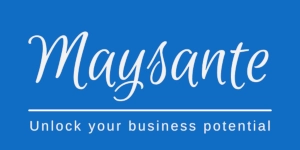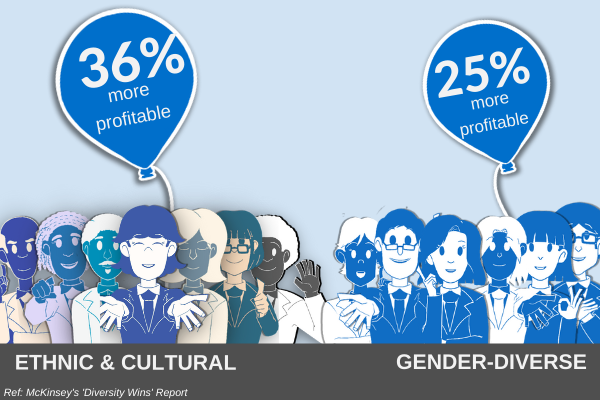Equality, Diversity and Inclusion are fundamental to the success of any organisation. According to McKinsey’s Diversity Wins report, there is a direct correlation between having a diverse executive team and business financial performance. The report shows that in 2019, companies with the highest representation of ethnic and cultural diversity were 36% more profitable than those with the lowest representation. Similarly, more gender-diverse executive teams yielded 25% more profitability than those with the lowest representation.
Equality, Diversity and Inclusion matter to most stakeholders. Your stakeholder community includes your shareholders, customers, suppliers, members of the public and investors. It is thus not surprising that more diverse and inclusive organisations are performing better. People with interest in your organisation consider more than your product and your brand. Corporate social responsibility, social impact, ethical, moral and environmental impact are becoming increasingly important. What do your brand and organisation stand for?
In the UK, the Equality Act 2010 offers legal protection from discrimination in the workplace and society at large. But, discrimination in the workplace and society is far from over. Organisations make bold statements around equal opportunities all the time. It is therefore very common to find organisations issuing statements such as ‘we are an equal opportunity employer’, ‘we have zero tolerance for discrimination’ or ‘we are a disability confident employer’.
What do these actually mean in practice? What evidence can you find if you go knocking on their doors?
Equality, Diversity and Inclusion
Diversity is understanding and recognising the differences in people. Inclusion is about valuing individual differences and using them as enabling tools for individuals. According to the Human Rights Commissioner, Equality is ‘about ensuring that every individual has an equal opportunity to make the most of their lives and talents’.
Your approach to Equality, Diversity and Inclusion hugely impacts directly the well-being and performance of your employees and those close to them. If you are of the view that they are responsible for telling you what you should do, then you are a big part of the problem. Organisations and their leaders have a key part to play in creating a safe environment where everyone can flourish. Everyone should feel they belong and be their authentic self at work.
It is difficult to address equality. This is because diversity and inclusion cover a wide range of protected characteristics. There are nine such characteristics under the Equality Act.
- age
- disability
- gender reassignment
- marriage and civil partnership
- pregnancy and maternity
- race
- religion or belief
- sex
- sexual orientation

Each characteristic has sub-characteristics that are equally important. You certainly cannot have a one size fit all approach. It is not enough to throw policies at them. You cannot go through a checklist exercise and park it to one side.
Leadership Role in Getting Equality, Diversity and Inclusion Right
Everyone has a role to play to ensure that the workplace is a safe space for all. Equality, Diversity and Inclusion must be high up on the board’s agenda in order to have an impact. You must have a true champion on the board. The role of the lead champion must go beyond reporting on the statistics within your organisation. They must also be accountable. It must encompass a proactive approach to increasing awareness, providing budgets for initiatives, allocating time, shaping and changing culture and behaviours. You must also appoint ambassadors at all levels in your organisation to increase awareness.
Your equal-opportunity practices should be evident at every stage of your organisation, your customer journey and employee lifecycle. You should treat everyone with respect. Reasonable adjustments must be made where necessary in order to accommodate differences. You must invest in creating the right atmosphere. This can be done by offering training, awareness and support for all. You should also encourage open discussions about issues surrounding Equality, Diversity and Inclusion. You should check and evaluate from time to time if the measures you have put in place are working.
Company Culture and Environment
You must create and drive a culture that encourages inclusion across the board. Although some of the protected characteristics may not be obvious for some, the culture of your organisation should be such that it makes everyone feel welcome. These protected characteristics include disability, religion or belief, sexual orientation or marriage and civil partnership. Comments in meetings and mannerisms around certain topics may contribute to people feeling uncomfortable. Other factors such as venues for meetings, choice of food for refreshments etc., may also contribute to people feeling uncomfortable.
For example, arranging your company meetings in a pub may alienate Muslims. Another example, is having company socials in the evenings, outside of working hours may mean employees with young families, childcare and caring responsibilities may not be able to attend. The affected group of employees are predominantly females. But there is an increasing number of males who have parental or caring responsibilities. Therefore, consideration should be given to these areas.
Does your working environment and facilities cater for everyone? You may want to give considerations for the following:
- accessibility;
- lighting;
- noise levels;
- furniture;
- working equipment;
- refreshment stations; and
- IT equipment and software.
When you are having meetings and discussions, consider reasonable adjustments to accommodate people who need it. Knowing your workforce will help you to understand and identify the adjustments you may need to make.
Pay, Recognition and Rewards
This is an area where there can be significant differences and discrimination against various individuals. The fact that gender pay gap reporting is mandatory for companies with more than 250 employees shows the gravity of the issue. The rate at which the gap is closing is still pretty slow. There have been calls for the government to legislate to make diversity reporting mandatory too.
For a long time, companies of all sizes including government departments have gotten away with discriminating against individuals who fall within the protected characteristics, particularly when it comes to race and disability. You’ll find pockets of examples of tokenism, where a handful of individuals are brought onboard to tick off boxes.
You should be asking yourself if you offer equal opportunities to all. When you analyse your organisation, it will help you know if you pay people doing the same job with similar attributes the same amount. These attributes include skills, qualifications and expertise. When it comes to pay review, how transparent is your pay review process?
Gender Balance and Diversity in the Boardroom
When it comes to the selection of leadership teams and board members, decision-makers often tend to select people they feel comfortable around. People they can socialise with. People who remind them of themselves. The ‘people like me’ syndrome. A lot of emphasis is placed on personality and team fit. These are certainly necessary. However, to enrich your experience as a board and leadership team, you need to be open and embrace diversity. You will also have to step out of your comfort zone. Create an inclusive boardroom where people from diverse backgrounds, gender and with different abilities can see themselves. Representation matters. Inspire the next generation of leaders by setting a great example.
Getting it Right
To conclude, here are 10 top tips for getting it right.
- You will have to live and breathe Equality, Diversity and Inclusion.
- Create an organisational culture where everyone is included and is welcome.
- Lead by example. Let your boardroom represent what you believe in and stand for.
- Choose strong passionate advocates and champions for Equality, Diversity and Inclusion.
- Provide training for your board and leadership as well as your workforce.
- Provide Equality, Diversity and Inclusion coaching and mentoring.
- Go beyond policies and be proactive with initiatives that further creates awareness.
- Be transparent with your pay, reward and recognition programmes.
- Treat all your stakeholders with respect. Their experiences should be great irrespective of who they are.
- Create equal opportunities for all and give everyone an equal chance. Everyone deserves a fair chance.

